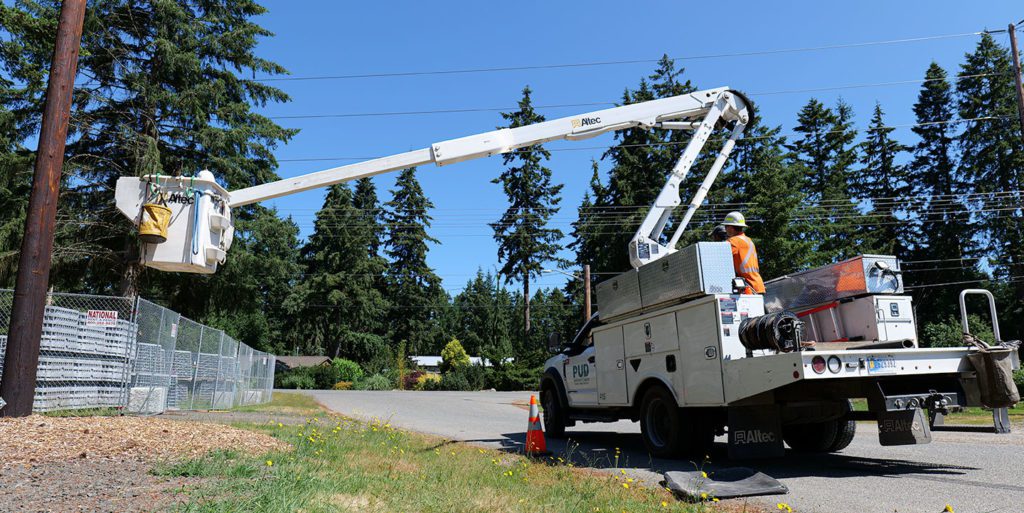Safety Up Above & Down Below
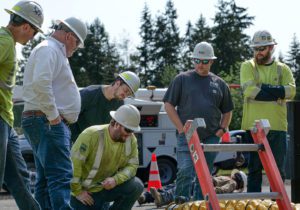
“Apprentice, how long do we run the vacuum until it clears the space,” said John Spain, training instructor for Northwest Safety Services, LLC, as he walked the perimeter of the in-ground electrical vault.
Line Apprentice Garrett Bradley scans the spec plate on the bright yellow vacuum pump and, after some quick volume calculations, determines 1.5 minutes of run time.
1.5 minutes is an eternity when your teammate is unresponsive at the bottom of a vault.
“It may not look like it, but below ground that air can be poisonous,” Spain said to the PUD line crew and water team encircling the area. But they must wait–in this scenario to enter early means becoming yet another victim.
Beside the vault, Bradley uncoils a long yellow accordion hose meant to pull dangerous gases from below, while Line Apprentice Tyler Gale kneels beside him, placing an air detector into the vault. The indicator flashes all clear and the team lowers a ladder to the full-size training manikin slumped across the vault floor.
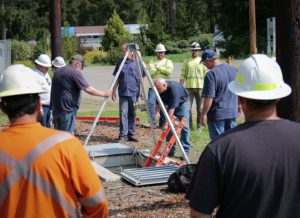
Water Treatment Plant Operator, Jerry Rubert, ascends into the vault to secure the fallen teammate, while aboveground the water team positions a heavy-duty aluminum tripod with a hand-crank winch over the opening. Within seconds, Rubert has secured a makeshift lifting harness to the manikin, and it is winched from the space onto the ground.
“It’s not always pretty getting someone out of a confined space,” Spain said, “But what’s important is getting them out fast.”
A quick reset with the accident-prone manikin, and it’s the PUD line crews turn to step into the hole.
Annual Training
Each year PUD line and water crews participate in exercises reviewing confined space rescue, pole top rescue, and bucket rescue scenarios. During the full day training, crews conduct 3 hours of class time review, followed by in-field practical testing. The trainings are a good refresher for veteran crew members and an essential reminder of the importance of rescue training for PUD apprentices.
Pole Top Rescue
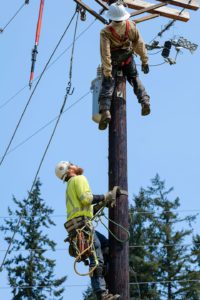
With the vault sealed up, crews turn their attention upward to the training poles outside the PUD’s 310 Four Corner Road headquarters.
Spain outlines the scenario: The manikin crew member contacted live lines and is dangling (harnessed) 25 feet in the air. The power is hot and must be made safe before rescue can be attempted.
One by one, PUD line crew enter the scene.
Line crew foreman, Jonathon Dehnert, steps to the pole. “Eric, call 9-1-1; Ted, get the AED from the truck,” Dehnert says, making eye contact and pointing to each team member. An essential part of any rescue is presenting needed tasks and communicating clearly before and during the rescue. Dehnert secures his harness to the pole, digs in his boot spikes (known as gaffs) and begins climbing.
At the top of the pole, tethered to the crossarm, the manikin hangs limp–180 pounds of dead weight. Dehnert scales the pole in seconds and uses the “hot stick” placed in the scene to disconnected the nearby cutaway. With the cutaway secured–signifying the scene has been made safe–Dehnert turns his attention to the incapacitated manikin.
This is the big challenge, Spain told PUD staff who came to see the training in action. Safely transitioning the manikin requires securing a pulley and line to the pole crossarm, and fashioning together a temporary under-arm harness.
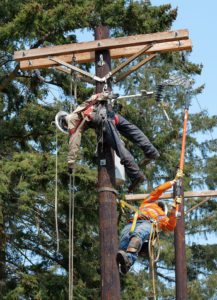
Just like the vault rescue, Spain said, time is critical.
Dehnert secures the pulley line to the underarm harness. “Take the weight!” Dehnert calls down to linemen on the ground who begin to pull. Dehnert cuts the manikins main harness strap and the body swings free and is quickly lowered by the line crew.
On the ground, line crew catch their breathe and reviews each point of the rescue. A quick reset of the manikin with the line truck and the scene unfolds again.
Bucket Rescue
Line crew spend a significant amount of time high in the air inside what is known as the “bucket” attached to their specially designed line truck. The bucket offers a lashing point for fall protection gear and area for essential gear. Buckets vary in size from one to two-person. Line work takes place day or night and under all weather conditions and potentially around energized lines, so line crew must practice bucket rescue techniques designed to mimic contact with a live line.
Like pole top rescues the crew must first establish that help is on the way before beginning the rescue, but that is where the similarities end.
Truck-mounted buckets can be controlled from the bucket itself or from the back of the vehicle. The scenario represents a bucket still in contact with a live line, which could potentially energize the truck as well. Line crew must properly “hop” onto the line truck to ensure they are not grounded when they make contact.
The manikin (slumped in the bottom of the bucket) is then lowered out of the hazard zone to the crew waiting on the ground. Line truck buckets are designed with a tilt function to allow easier access by team members.
Training opportunities like confined space, pole top, and bucket rescues provide PUD line and water crews with a foundation of life-saving experience if the situation arises.
